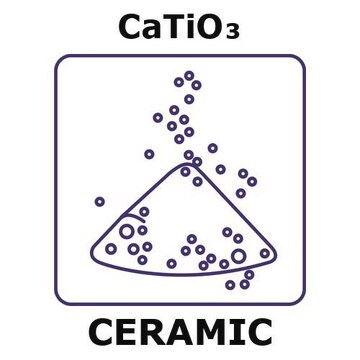633801
Calcium titanate
nanopowder, <100 nm particle size (BET), 99% trace metals basis
Sinónimos:
CALCIUM TITANIUM OXIDE
About This Item
Productos recomendados
Nivel de calidad
Análisis
99% trace metals basis
formulario
nanopowder
superficie
5-20 m2/g
tamaño de partícula
<100 nm (BET)
densidad
4.1 g/mL at 25 °C (lit.)
cadena SMILES
[Ca++].[O-][Ti]([O-])=O
InChI
1S/Ca.3O.Ti/q+2;;2*-1;
Clave InChI
AOWKSNWVBZGMTJ-UHFFFAOYSA-N
¿Está buscando productos similares? Visita Guía de comparación de productos
Categorías relacionadas
Código de clase de almacenamiento
11 - Combustible Solids
Clase de riesgo para el agua (WGK)
WGK 2
Punto de inflamabilidad (°F)
Not applicable
Punto de inflamabilidad (°C)
Not applicable
Equipo de protección personal
Eyeshields, Gloves, type N95 (US)
Elija entre una de las versiones más recientes:
¿Ya tiene este producto?
Encuentre la documentación para los productos que ha comprado recientemente en la Biblioteca de documentos.
Los clientes también vieron
Artículos
Synthesis, Properties, and Applications of Perovskite-Phase Metal Oxide Nanostructures
Perovskite-phase metal oxides exhibit a variety of interesting physical properties which include ferroelectric, dielectric, pyroelectric, and piezoelectric behavior.
Nuestro equipo de científicos tiene experiencia en todas las áreas de investigación: Ciencias de la vida, Ciencia de los materiales, Síntesis química, Cromatografía, Analítica y muchas otras.
Póngase en contacto con el Servicio técnico








